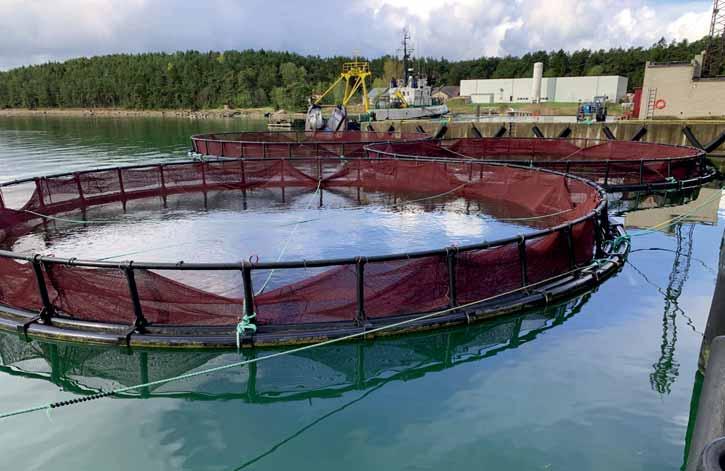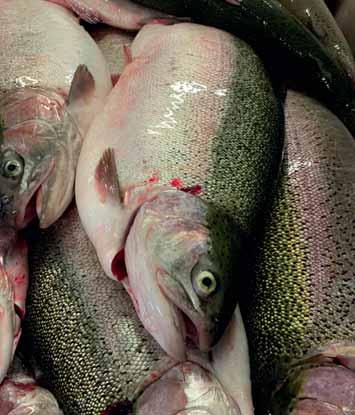
6 minute read
PRFoods is Estonia’s sole farmer of trout in the sea
by Eurofish
PRFoods is Estonia’s sole farmer of trout in the sea A quest to expand Baltic Sea farming operations
The aquaculture sector in Estonia is modest with a production of about 1,000 tonnes in 2018. In comparison, Latvia produced about 800 tonnes and Lithuania some 3,500 tonnes. Rainbow trout is the main species farmed in Estonia and among the companies cultivating it is PRFoods, which specialises in the production, processing, and sales of fi sh, primarily rainbow trout.
Advertisement
Cages are used to on-grow rainbow trout in the Baltic Sea. The fi sh are introduced into the cages at about 700 g on average and reach 3-4 kg some six months later.
PRFoods has fi sh farming activities in Sweden and Finland, as well as processing facilities in Estonia, Finland, and the UK. While the company only produces rainbow trout, its processing and trading activities also include salmon, sourced mainly from Norway. Th e total annual production of rainbow trout amounts to about 2,000 tonnes of which Estonia supplies some 200 tonnes. Th e rest is grown in freshwater lakes in Sweden and in the Baltic Sea in Finland. Explaining the focus on rainbow trout, Margus Rabane, the director with overall responsibility for farming activities, says that it is the most successful fi sh the company has farmed. Other species have been tried in the past, but their performance was not as good as rainbow trout’s. Production in Estonia is currently only a small fraction of the total, but the company plans to increase it and has applied for several permits. I hope that in 2022 we can start a bigger production in Estonia, says Mr Rabane. Th e current farming site is off Saaremaan, the largest Estonian island, and in contrast to the Finnish sites, it is very exposed with clear passage right up to the Bothnian Bay in the north. Th e sites in Finland are located within
an archipelago and are therefore more sheltered.
Open sites have some benefi ts…
An exposed site is a mixed blessing. Winds, waves, and currents are stronger which allows for higher water exchange rates and generally better water quality with larger nutrient assimilation capacity and higher levels of dissolved oxygen. Accumulation of waste matter and residual feed under the cages is prevented because of movement of the water. Fish in cages exposed to currents may also have better fl esh quality and texture as a result of having to swim against the currents. On the other hand, farming infrastructure (cages, nets, ropes, chains, etc.) at exposed sites is more vulnerable to damage and degradation, access for personnel is more diffi cult, and if the currents are too strong the fi sh will suff er. Th e current site in Estonia is in a bay and only 800-900 m from the coastline, while the next site will be some 8 km away and 2-3 km from the coast. Th e fi sh that are put in the cages in spring are already large, weighing between 500 and 1,000 g individually. Th ey are harvested in late October or early November, by which time they have reached between 3 and 4 kg depending on the initial weight. Th e fi sh are typically obtained from local fi sh farmers who grow the fi sh in raceways or, in one case, in ponds. Fish from recirculation aquaculture systems (RAS) have also been on-grown in the sea cages, but unlike the fi sh from raceways, RAS-grown fi sh do not produce roe. In general, all the fi sh that is put in the sea in Estonia is sourced within the country. We do not move large fi sh from one country to another, says Mr Rabane, because of the risks to the wellbeing of the fi sh from the transport, and also because of potential biosecurity issues. Suppliers of fi sh for on-growing must have biosecurity protocols in place to reduce the risk of disease. In addition, moving large fi sh to the north of Sweden, where the climate can be very harsh, jeopardises their survival. On the other hand, fi ngerlings are transported between countries, for example, from Finland to Sweden and Estonia. In Sweden the company has a hatchery and although it does not own broodstock it can initiate production with certifi ed specifi c pathogen free (SPF) eggs or fi ngerlings from third-party suppliers.
To be competitive one must play cleverly
Producing rainbow trout of up to 4 kg places the fi sh in the same category as salmon, which means competing with Norwegian production. As Mr Rabane states, rainbow trout grown in the Baltic Sea is a diff erent fi sh from the trout or salmon grown in the Norwegian Sea. Fish grown in the Baltic will not reach the same size as fi sh grown in Norwegian waters. We have to be clever to compete, he adds. Th us, as a vertically integrated fi rm with its own production, processing, and sales, PRFoods can balance the production to suit its needs, freezing fi sh when necessary to be processed later, and adjusting the product mix to align closely with market demand giving it the necessary fl exibility to compete.
At the processing facility every conceivable kind of product is made from the trout—cold smoked, gravad, hot smoked, fi sh balls, marinated products, trout roe, fresh fi llets, fresh portions, frozen fi llets, frozen portions. Th e fi sh is processed at one facility in Estonia, some 70 km from the on-growing site and at two plants in Finland. All the Swedish fi sh is delivered to the northernmost plant in Finland. In Finland the company also has a production of trout roe. However, as the female fi sh approach sexual maturity their metabolism orients towards the growth of ovaries and eggs to the detriment of fl esh quality and yield, and with undesirable changes in fl esh colour. Th ere is thus a trade-off between high quality roe and high quality fl esh. Researchers at a Norwegian research organisation studying rainbow trout production at a local company concluded that for optimal roe yield the fi sh should be harvested in December, while for better fl esh yield the optimal period was October/November. At PRFoods the solution has been to carefully monitor the fi sh throughout the season and to carefully choose the time of harvesting to optimise the quality of both products. Th e company has gained a lot of experience over the years and has used this knowledge to control the colour of the fi llet and the skin. It is now working to improve the quality of the fl esh so that the eff ect of maturation is minimised.

The rainbow trout is processed at the company’s facilities in Estonia and Finland.
Licenses for production in the Baltic Sea are diffi cult to acquire
PRFoods collaborates with a major Danish supplier of fi sh feed and with them has developed a new feed with one of the smallest environmental impacts, according to Mr Rebane. Apart from reducing emissions of phosphorus the feed supplies the fi sh with a number of nutritionally valuable components making it a healthful and tasty product for consumers. Th e fi sh are farmed without the use of antibiotics or other chemicals as the sites rely on good farm management and on suppliers that are thorough and responsible in their approach to disease prevention. In the future, the plan is to expand production in Estonia but gaining the necessary environmental clearances is a diffi cult task. Th e administration is considering moving the industry










